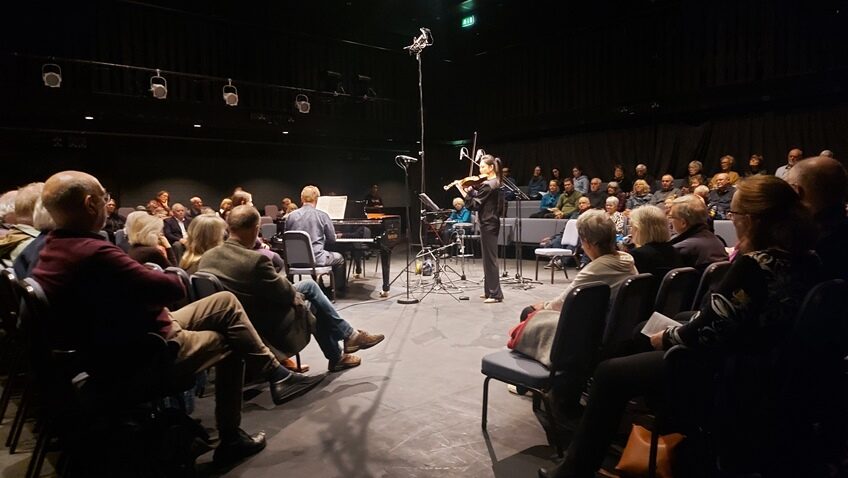In this spellbinding evening of mesmerising musicianship and exciting musical togetherness a programme of glorious music, enchanting and exhilarating from start to finish, ensured a constant flow of warm joy.
Two works by Vaughan Williams, in this 150th anniversary year since his birth, were the first luxurious treats. With regular violinist Ben Nabarro indisposed, Emily Sun stepped in to perform, with delight, The Lark Ascending (1914), a piece that’s topped Classic FM’s Hall of Fame twelve times. Ensuring over-familiarity didn’t dull impact, Emily instilled fresh, in-the-moment vibrancy into every note, her lark soaring sweetly to stratospheric heights and gracefully, delicately dipping as she recreated (musically) the bird’s acrobatic loop-the-loop swoops, energetic trills and chatterings and its moments of well-earned rest, while Tim Horton’s piano set us in the open landscape spread below, looking heavenwards in fascination and awe.
Ralph Vaughan Williams wrote his Concerto in A Minor for Oboe and Strings in 1944 for great oboist of the day, Leon Goossens. So great was Goossens’ love of music that, when his teeth were wrecked in a car accident, he learnt, at 64, to play the oboe in a new way and achieved a sound even more glorious than before. There’s hope for us all! Adrian Wilson’s oboe playing, also always a treat, took us through flows of lyrical, dreamy calm and longing into perky scurryings and spiky, agile bubblings (some reminiscent of that ascending lark) whilst weaving into the melodic beauty of the fabulously harmonised violin, viola, cello and bass.

Around 1903-1905, Maurice Ravel, friend and mentor to Vaughan Williams, wrote Sonatine for piano. Amusingly, the first movement was written as an entry to a magazine competition, which stated that compositions must be just 75 bars long. Ravel was the only entrant but, since his offering was 77 bars long, he was disqualified and the competition declared void. But waste not, want not: with a couple more bars added, the piece forms the first movement of his short, 3-movement Sonatine, a melodious, comforting composition, its delightful rippling, impressionist palette of colours and atmospheres brought to us courtesy of Tim Horton.
And for the finale… Vaughan Williams’ Quintet in C Minor for violin, viola, cello, double bass and piano, composed and revised, like Ravel’s Sonatine, between 1903-05, in which Vaughan Williams uses that same rare combination of instruments as Schubert did in his Trout Quintet. Because this work didn’t come properly into the public domain until 2002 owing to Vaughan Williams’ own thoughts on the piece, it’s heard far less frequently than Schubert’s – which is a terrible oversight as it’s massively magnificent!
Thoroughly engaging from its opening, fiery proclamations, the piece enjoys a superb interplay and harmonic beauty of strings and piano. Creating a rich variety of textures, tones, moods, pace, contrasts and motif, it travels from soothing, lyrical contemplation and tranquility to sinister forebodings, brooding, impatient pacings, plucks, surges, stormy fury, accelerating urgency (reminiscent of the war not long passed, perhaps) and intense, climactic, movie-style excitement, while in the breathing spaces all is calm again with odd glimpses of those timeless, verdant pastures of the tranquil English country idyll peeping through.
A super programme of warm, melodious compositions, all played with heart and soul.
Eileen Caiger Gray
A recording of this performance will be broadcast on BBC Radio 3 in 2023, the date to be announced on Music in the Round’s website once available. To find out more follow this link.




